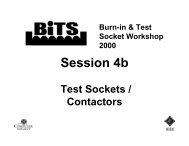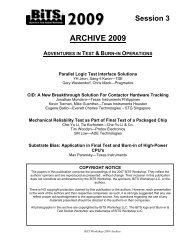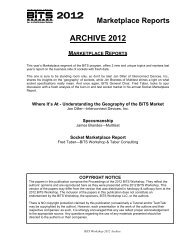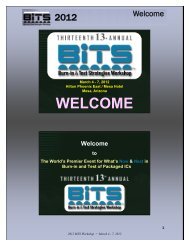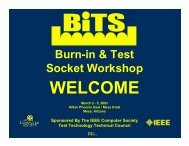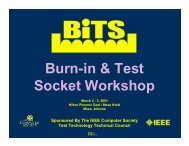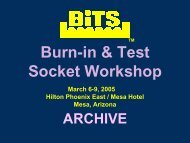Kelvin Contactors - BiTS Workshop
Kelvin Contactors - BiTS Workshop
Kelvin Contactors - BiTS Workshop
- No tags were found...
You also want an ePaper? Increase the reach of your titles
YUMPU automatically turns print PDFs into web optimized ePapers that Google loves.
Burn-in & TestSocket <strong>Workshop</strong>IEEEMarch 3-6 , 2002Hilton Phoenix East/Mesa HotelMesa, ArizonaIEEECOMPUTERSOCIETYSponsored By The IEEE Computer SocietyTest Technology Technical Council
COPYRIGHT NOTICE• The papers in this publication comprise the proceedings of the 2002<strong>BiTS</strong> <strong>Workshop</strong>. They reflect the authors’ opinions and are reproduced aspresented , without change. Their inclusion in this publication does notconstitute an endorsement by the <strong>BiTS</strong> <strong>Workshop</strong>, the sponsors, or theInstitute of Electrical and Electronic Engineers, Inc.· There is NO copyright protection claimed by this publication. However,each presentation is the work of the authors and their respectivecompanies: as such, proper acknowledgement should be made to theappropriate source. Any questions regarding the use of any materialspresented should be directed to the author/s or their companies.
Burn-in & Test Socket<strong>Workshop</strong>Technical ProgramSession 8Wednesday 3/06/02 10:30AMNew Products“<strong>Kelvin</strong> Contacting Solutions For Leadless Device Types”Gerhard Gschwendtberger - Multitest Elektronische Systeme GmbH“Interconnecting At 40 GHz and Beyond”Roger Weiss, PhD - Paricon Technologies Corporation“Electro-chemical Cleaning Process”Erik Orwoll - Nu Signal LLC
<strong>Kelvin</strong> Contacting Solutions forLeadless Device TypesGerhard GschwendtbergerProduct Manager <strong>Contactors</strong>Multitest elektronische Systeme GmbH & Co.KG
Leadless Packages3/28/022
Leadless PackagesLeadless Packages = JEDEC compliant QFNplastic package MO-220/MO-229MLFetc.MLPVQFNVQPFNTypical Package Sizes:2x1mm 3/5 lead up to 9x9mm 64 leadBody thickness ~1mmLead Pitch from 1.27mm down to 0.4mm3/28/023
<strong>Kelvin</strong> <strong>Contactors</strong><strong>Kelvin</strong> contactors are typically used for sensitiveresistance measurements at Analog/Mixed SignalandAutomotive applicationsElectrical principle: Two independent electricalconnections to the device lead allow to compensateparastic resistances between DUT and Tester.ifR12RR67R =2thenR1×R X=RR53/28/024
IC Package TrendsD o w n S i z i n gdevice size, lead pitch/sizeDIP, TOSOJSOP, SSOPTSSOPLeadlessCurrent <strong>Kelvin</strong> contactortechnologiesNew technologyrequired3/28/025
<strong>Kelvin</strong> <strong>Contactors</strong> for Leadless DevicesDesign ObjectivesElectrical:◆ High current capability◆ Repeatable contact resistance values◆ Low inductanceThermal:◆ Temperature range -55°C through 155°C◆ Low DUT temperature drift during test3/28/028
Contactor Design - Package DimensionsPackage Dimensions - TolerancesLeadPitch e1,270,80,650,50,4b(min)0,350,280,230,180,16B(max)0,470,40,350,30,27L(min)0,50,50,30,30,3Tolerances on D & Edimensionstypically +/- 0.15mmL(max)0,750,750,50,50,53/28/029
Contactor Design - Technology(mm)Pad dimensionslead pitch 0.4mmContact area worstcase:0.16 x 0.3 = 0.048mm 2<strong>Kelvin</strong> contact springgeometry / arrangement3/28/0210
Contactor Design - Features<strong>Kelvin</strong> contact spring block◆ Molded tungsten needles◆ No scrub◆ Needles penetrate oxide◆ 0.3N @ 0.3mm deflection◆ 0.1mm distance betweenadjacend needles◆ Minimum springpitch 0.4mm◆ PC board 10mm distanceto DUT3/28/0211
Contactor Design - Features3/28/0212
Contactor Design - Features<strong>Kelvin</strong> contact spring block - detail3/28/0213
Contactor Design - Socket ArrangementRectangular arrangement for leadless packages3/28/0214
Contactor Design - Dual Contact UnitAir connectionGuide pins(handler docking)Temperatureinsulation<strong>Kelvin</strong> contactspring blockGuiding holes(plunger reference)Base Plate3/28/0215
Contactor Design - Device PositioningGravity test handler - vacuum plungerGuiding doorGuiding bardDevicePlunger head3/28/0216
Design Evaluation - Contact SpringsContact springmarkson device pads3/28/0217
Design Evaluation - Contact SpringsContact spring marksMLF 4x4 20lead 0.5mmContact springsafter 500k insertions3/28/0218
Design Evaluation - Resistance Distribution300250Number of sources20015010050Contactresistancemeasurementstaken from 100DevicesMLP6x5 8leadTemperatureambient0120 140 160Contact Resistance mOhm3/28/0219
Design Evaluation - Contact ResistanceContact resistance versus number of insertions (ambient)150140Resistance mOhm13012011010090MLP6x5 8leadPIN 1PIN 2PIN 3PIN 4PIN 5PIN 6PIN 7PIN 8801 51 101 151 201 251 301 351 401 451Number of insertions x10003/28/0220
Evaluation Results - Maximum CurrentMaximum test current versus pulse durationCurrent I (A)10987654321010 50 100 250 500 1000Pulse (ms)Max. Current AmpBase:1 second test time3/28/0221
Evaluation Results - Temperature AccuracyTemperature drift DUT during test at 155°CTemperature °C154152150Time sStart of test40 80 120 160DUT temperature after 30 seconds testtime = 152,5°C3/28/0222
Evaluation Results - Temperature AccuracyTemperature °C-50-52-54-56-58-60Temperature drift DUT during test at - 55°CStart of test0 4 8 12 16 20 24 28 32 36 40 44 48 52 56 60 64 68 72 76 80Time sDUT temperature after 30 seconds testtime = - 53°C3/28/0223
Design Evaluation - SummaryMechanical:PackageJEDEC MO220 / MO229Lifespanmin 1Mio insertionsContact force 0.3NContact deflection 0.3mmElectrical:Contact resistanceMaximim currenttyp. 130mOhmcontinuous 1 AmpThermal:Temperature range -55°C up to 155°CTemperature accuracy +/- 3°C3/28/0224
®Interconnecting at 40 GHzand BeyondRoger Weiss, PhD1
®Problem DefinitionElectronic Capability Continuously EvolvesSmaller, Faster, Better Performance,Lower Cost and More FunctionalityLLLLComputer Speed and SizeWireless and TelecomMilitaryMedicalConventional Connectivity is Runningout of Speed2
®Core TechnologyParicon’s Interconnect TechnologyBased on ControlledElectromagnetic Alignment ofFerro-Magnetic Particles Within aPolymer Matrix3
®Core TechnologyAfter Several Years of Research Paricon HasPerfected a Long Promised CapabilityLCore Technology Acquired From Bell LabsLHigh Performance Materials DevelopedLImproved Manufacturing MethodsIntroducedLMechanical Interactions Understood4
®PariPoser ® Interconnect5
®®Our Name6
®Contact ResistanceContactResistance(Milli Ohms)THROUGH RESISTANCE CURVE252015Set 11050-3 -2 -1 0 1 2 3Normal Probability7
®Rise TimeTDT thru1.21.00.80.60.40.20.0250 300 350 400-0.2t [ps]RhoTHRU probesTHRU Mat'l. ATHRU Mat'l. BTHRU Mat'l. CTime domain response for transmitted signal8
®Electrical ParametersShunt Capacitance (G-S-G)Self Inductance30 femto Farad70 pico HenryRise Time (Same as Test System) 32 psDelay 1.5 ps9
®Resistance vs. Temperature12Thermal Coefficient Of Resistance10Resistance (mohm)86420Average ResistanceSilverBest FitR=R 0 [1+α 1 (T-T 0 )+α 2 (T-T 0 ) 2 ]α 1 =6.76x10 -3 C -1α 2 =72.9x10 -6 C -10 20 40 60 80 100Temperature (C)11
®Formulation DependentMaterial PropertiesL Isolation Gap*: As low as 0.010”L Nominal Operating PSI: 15 - 100 PSIL Current Capability*: Up to 1 Amp for 25 mil padL Environmental Seal: Silicone GasketL Size/Shape: Any shape < 12” x 30”L Pad size*:L Contact Materials:.025 inches TypicalNoble Metals*Data for 1mm LGA Array12
®Formulation DependentMaterial PropertiesL Solvent Resistance: ExcellentL Thermal Conductivity: 2 W/m -°CL Pitch:EngineeredL Thickness: 8-15 milsL Op. Temperature Range: - 40 to 160 CL Storage Temperature: -170 to 160 CL Durability:>500,000 cycles at18 PSI13
®Formulation DependentMaterial PropertiesL Burn-in Cycles>500 to 150 CL Contact Resistance 1 gig ohmL Frequency Range:At least 40 GHzL Glitch>2500 Hours perEIA-54014
®Technical/Market AdvantageLPerformanceLScalabilityLCostLQuick Time to MarketLHighly ConfigurableLEnables New Approaches15
®PariPoser ® Components16
®Development Test Socket17
®10 GHz Test Socket18
®10 GHz Test Socket19
®10 GHz Translation Socket20
®Production Socket21
®Summary Benefits of the PariPoser ® AnisotropicConductive Interconnection Fabric.LConducts Only in the Z-AxisLProvides Multiple Signal Paths per Pad.LExceeds Industry Electronic Needs.LExtendable to Very High Density.LInterconnect at 40 GHz and BeyondLExtends Interconnection capabilities to newdimensions.22
®The FutureProjected CapabilityLDie scale interconnection 0.004” pitch demonstratedLWafer Scale Test Probe for 300mm23
ELECTRO-CHEMICALCLEANING PROCESSMarch 2002 <strong>BiTS</strong> <strong>Workshop</strong>Presented by Erik OrwollPresidentNu Signal LLC
INTERCONNECT DEGRADATIONCauses:Tin Lead Transfer (Metallic Formation)Mechanical Wear (Surface finish change)Localized areas of plating are removedPoor Plating adhesionOxidation2
TOPICS TO BE ADDRESSEDRemoval of Tin Lead Transfer & OxidizedMetallicsMethod for Detecting Exposed Base MetalLead Free SolderProcess can be applied to both Burn-In andTest3
CURRENT METHODS FORTIN/LEAD REMOVALMechanical Removal - Typically brass or nylonbrushes. Consistency is difficult and damage canoccur.Chemical Cleaners - Can be harmful to contactorplating, base metal, and socket housings. Also volatile& toxic.Abrasive - Ceramic or similar material. Can causedamage to plating or base metal.Ultra-Sonic Cleaning - Removes dirt and looseparticles, but has little or no effect on transferredmetals.4
TIN LEAD DEPOSITSGold PlatingSolder Build-UpExcessiveSolder Build-Up5
TIN LEAD DEPOSITS4 Point Crown Pogo PinSolder Build-UpSolder Build-Up6
ELECTRO-CHEMICAL CLEANINGPROCESSMetal fouling, which is deposited on the contactor, isselectively removed by an electrochemical processwhich is innocuous to the connector base metalAn electrolyte is suspended between the base metaland a collection plate, and a potential is appliedTin Lead deposits are solubilized and deposited onthe collection plateThe potential is maintained until process is complete7
“REVERSE” PLATING PROCESSThis process is similar to standard electroplating.However, the potential is reversed,causing the Tin/Lead deposits to be removed fromthe base metal and released into solution (SeeFigures 1 & 2)Tin/Lead deposits form on a “collection” plate8
FIGURE 1Diagram of typical plating process9
FIGURE 2 (Socket Inverted)10
CollectionPlateELECTROCHEMICAL TRANSFERTest Set-upShortedBGADevice11
DEPOSITS ON COLLECTION PLATECollectionPlateSolderDeposits12
MID-PROCESS CONTACTCONDITIONSolderRemovedRemainingSolder13
ELECTRICAL DATA8BULK RESISTANCE (Ohms)7.576.561 CYCLE = 1000 INSERTIONS & 1 HR @ 150 CCLEANEDSOCKET #1SOCKET #25.50 1 2 3 4 5 6 7 8 9 10 11CYCLE COUNT14
BASE METAL DETECTIONA special solution is applied to the socketafter it has been cleaned to detect thepresence of copper. If plating is not present(typically Nickel/Gold), the exposed area willbe highlighted with a stainThe purpose is to highlight the damagedcontacts and to assess replacement15
PERIODIC CLEANINGCleaning should occur at regular intervalsto avoid interconnect failuresThe number of cycles and conditions ofuse determine the intervalCommon Values:Test Contactor - 20,000 cyclesBurn-In Connector - 1000 cycles16
LEAD FREE SOLDERLead Free Solder can be accommodatedwith minor modifications to the electrolyticsolutionConcentrations of up to 5% Copper orSilver are acceptable17
AdvantagePROS / CONSSolder is removed without risk of mechanicaldamage to base metal or gold platingConnector life is extendedDisadvantageProcess requires connectors to be cleaned“off-line”Patent Pending18



